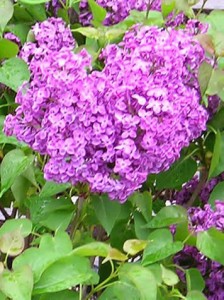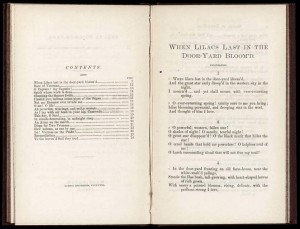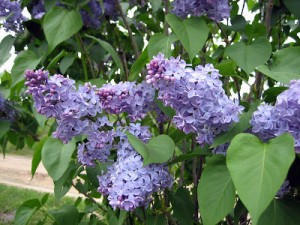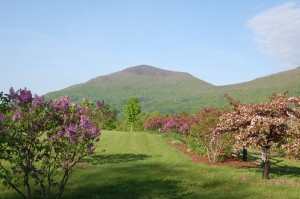
May is all about lilacs! Every New England house feels more like a home with at least one lilac somewhere in the yard. I grow “Pocahontas” (Syringa x hyacinthiflora ‘Pocahontas’) and I absolutely love it. It has a large leaf but does not mildew. It has deep purple flowers and a wonderful classic scent. It is also one of the earliest to bloom.

If I had room for more lilacs, I would add a white, probably the utterly reliable old standby Madame LeMoine (Syringa vulgaris ‘Madame Lemoine’).

When considering which lilac to purchase, I suggest you take a walk through any public garden near you in mid-May. I first fell in love with Pocahontas at the Arnold Arboretum in West Roxbury, MA. You really need to see your lilac in bloom before you decide. You can also tour the lilacs at your largest local garden center, but seeing them at their mature size in the garden is very helpful. I also believe that there can be little improvement on the underplanting at the Arnold Arboretum: bleeding heart, forget-me-nots, buttercups and long dewy grass.
Other standouts at the Arnold Arboretum are:
Syringa pubescens subsp. patula ‘Miss Kim’ – this lilac is very popuar because it doesn’t get too too huge. Orchid pink (pale purple) flowers. Fragrant.
Syringa meyeri ‘Palibin’ (“dwarf Korean lilac”) – another smaller lilac. Pink. Small leaves.
Syringa vulgaris ‘President Lincoln’ – pale blue, fragrant
Syringa vulgaris ‘Primrose’ – yellow! Well, very pale yellow – more like cream when open – but still, something new.
Syringa hyacinthiflora ‘Maiden’s Blush’ – pink, fragrant.
Syringa vulgaris ‘Charles Joly’ – magenta, fragrant



These are classic lilacs and not too hard to find. If you do have trouble locating your perfect lilac, they are easy to find on-line but they’ll be small. I couldn’t find Pocahontas anywhere and ended up ordering three tiny sprigs from Canada. One of them died within a year but two are doing well. The very next year, wouldn’t you know it, I stumbled across big, gorgeous pots of Pocahontas at a nursery in Vermont. I bought one to replace the sprig that didn’t make it and it is towering over the other two. Moral of the story is buy in person if you can.
Moving on to lilac literature…

When Lilacs Last in the Dooryard Bloom’d was written by Walt Whitman shortly after the assassination of President Abraham Lincoln in April 1865.
When Lilacs Last in the Dooryard Bloom’d
BY WALT WHITMAN
1
When lilacs last in the dooryard bloom’d,
And the great star early droop’d in the western sky in the night,
I mourn’d, and yet shall mourn with ever-returning spring.
Ever-returning spring, trinity sure to me you bring,
Lilac blooming perennial and drooping star in the west,
And thought of him I love.
2
O powerful western fallen star!
O shades of night—O moody, tearful night!
O great star disappear’d—O the black murk that hides the star!
O cruel hands that hold me powerless—O helpless soul of me!
O harsh surrounding cloud that will not free my soul.
3
In the dooryard fronting an old farm-house near the white-wash’d palings,
Stands the lilac-bush tall-growing with heart-shaped leaves of rich green,
With many a pointed blossom rising delicate, with the perfume strong I love,
With every leaf a miracle—and from this bush in the dooryard,
With delicate-color’d blossoms and heart-shaped leaves of rich green,
A sprig with its flower I break.
There is a lot more to this poem – but by then we are far from lilacs. Maybe it is enough to remember that lilacs bloom in May (or April, if you are living in the Potomac watershed). Whitman ends thusly: “Lilac and star and bird twined with the chant of my soul, / There in the fragrant pines and the cedars dusk and dim.”



